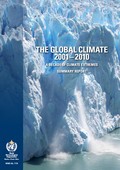World Meteorological Organization Report on Climate extremes 2001-2010
GENEVA 3 July 2013 - The world experienced unprecedented high-impact climate extremes during the 2001-2010 decade, which was the warmest since the start of modern measurements in 1850 and continued an extended period of pronounced global warming. More national temperature records were reported broken than in any previous decade, according to a new report by the World Meteorological Organization (WMO).

The report, The Global Climate 2001-2010, A Decade of Climate Extremes, analysed global and regional temperatures and precipitation, as well as extreme events such as the heat waves in Europe and Russia, Hurricane Katrina in the United States of America, Tropical Cyclone Nargis in Myanmar, droughts in the Amazon Basin, Australia and East Africa and floods in Pakistan.
The decade was the warmest for both hemispheres and for both land and ocean surface temperatures. The record warmth was accompanied by a rapid decline in Arctic sea ice, and accelerating loss of net mass from the Greenland and Antarctic ice sheets and from the world’s glaciers. As a result of this widespread melting and the thermal expansion of sea water, global mean sea levels rose about 3 millimetres (mm) per year, about double the observed 20th century trend of 1.6 mm per year. Global sea level averaged over the decade was about 20 cm higher than that of 1880, according to the report.
Impacts: During the decade 2001-2010, more than 370,000 people died as a result of extreme weather and climate conditions, including heat waves, cold spells, drought, storms and floods, according to the data provided by the Centre for Research on the Epidemiology of Disasters. This was 20% higher than 1991-2000. This increase is due mainly to the 2003 heat wave in Europe and the 2010 in Russia which contributed to an increase of more than 2000% in the global death toll from heat waves (from less than 6000 in 1991-2000 to 136 000 in 2001-2010).
On the other hand, there was a 16% decline in deaths due to storms and 43% decline in deaths from floods, thanks mainly to better early warning systems and increased preparedness and despite an increase in populations in disaster-prone areas.
According to the 2011 Global Assessment Report, the average population exposed to flooding every year increased by 114% globally between 1970 and 2010, a period in which the world’s population increased by 87% from 3.7 billion to 6.9 billion. The number of people exposed to severe storms almost tripled in cyclone-prone areas, increasing by 192%, in the same period.
Click here to go to full WMO News Release
Download the website sponsorship guide


